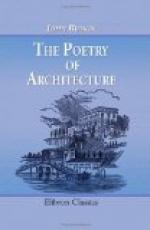[Footnote 11: This too refers to the unwritten sequel.]
[Illustration: FIG. 6. The Highest House in England.]
59. We cannot, then, be surprised at the effort at ornament and other fancied architectural beauties, which injure the effect of the more peaceful mountain scenery abroad; but still less should we be surprised at the perfect propriety which prevails in the same kind of scenery at home; for the error which is there induced by one mental deficiency, is here prevented by another. The uncultivated mountaineer of Cumberland has no taste, and no idea of what architecture means; he never thinks of what is right, or what is beautiful, but he builds what is most adapted to his purposes, and most easily erected: by suiting the building to the uses of his own life, he gives it humility; and, by raising it with the nearest material, adapts it to its situation. This is all that is required, and he has no credit in fulfilling the requirement, since the moment he begins to think of effect, he commits a barbarism by whitewashing the whole. The cottages of Cumberland would suffer much by this piece of improvement, were it not for the salutary operation of mountain rains and mountain winds.
60. So much for the hill dwellings of our own country. I think the examination of the five examples of the cottage which I have given have furnished all the general principles which are important or worthy of consideration; and I shall therefore devote no more time to the contemplation of individual buildings. But, before I leave the cottage altogether, it will be necessary to notice a part of the building which I have in the separate instances purposely avoided mentioning, that I might have the advantage of immediate comparison; a part exceedingly important, and which seems to have been essential to the palace as well




